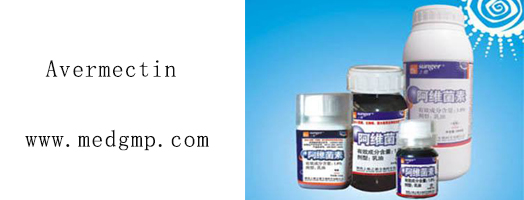
- Online pavilions:
- Veterinary medicines
- Veterinary raw materials
- Other
- Asia
- America
- medical instruments

News briefing: Application and explanation of avermectin injection for animals
Introduction of Avermectin
Avermectin is a natural fermentation product of Streptomyces avermus. Ivermectin is a semi-synthetic macrolide which has been modified by structure. The main differences between them are C22 and C23. Avermectin is a double bond and Ivermectin is a double hydrogen single bond.
Anthelmintic mechanism
This product mainly contains ivermectin B1 (B1 alpha +B1 beta) not less than 92%, of which B1 alpha must not be less than 80%. This product is white or light yellow powder, tasteless. It is soluble in ethyl acetate, acetone and chloroform, slightly soluble in methanol and ethanol, slightly soluble in n-hexane and petroleum ether, and almost insoluble in water. The repellent mechanism, repellent spectrum and pharmacokinetics of abamectin were similar to those of ivermectin. The repellent activity of abamectin was similar to that of ivermectin, but the property of abamectin was unstable, especially sensitive to light, and it was easy to inactivate and reduce its efficacy if it was not stored.
Illustrating
The repellent spectrum of abamectin to animals is similar to that of ivermectin. Taking cattle as an example, the recommended dosage of abamectin (200 UG /?) is injected subcutaneously into cattle, and the almost repellent worms are: Austella ostreatus (adults, stage 4 larvae, dormant larvae), Haemonchus burgdorferi (adults, stage 4 larvae), Trichinella albopictus (adults), Cupressus. Nematodes (adults, stage 4 larvae), Sheep Schubert nematode (adults), Radioactive Esophageal Mouth Nematode (adults, stage 4 larvae), Melanogyne fetalis (adults, stage 4 larvae). Avermectin can prevent repeated infection of Oster nematode, Haemonchus burgdorferi, Cupressus pallidum nematode and radiation esophageal ostium nematode in at least 7 days. Avermectin can even keep efficacy against Meloidogyne fetalis for 14 days. The elimination of bovine palatal louse can at least maintain over 56 days.
The repellent effect of Abamectin on female blood-sucking ticks of Bovine ticks was maintained for at least 21 days, and the spawning rate of the remaining female ticks was reduced. Avermectin is also highly effective against certain winged larvae that reproduce in stable manure, such as cattle given a subcutaneous injection of 200 ug/kg, which, according to fecal examination, can prevent the development of buffalo flies (Haemophilus orientalis) for at least 21 days. Because abamectin is mostly excreted by feces, the development of larvae of certain bipterous insects that reproduce in manure is hindered.
Therefore, this kind of medicine is the most effective manure and fly killing agent in pasture. After a subcutaneous injection of 200 ug/kg, the residual Avermectin in feces had little effect on the adult beetle larvae in cow dung, but the larvae did not develop normally until 21 days after administration (some of them were 28 days). The toxicity of avermectin is slightly stronger than that of ivermectin. Its properties are not very stable, especially sensitive to light, rapid oxidative inactivation, therefore, the various dosage forms of abamectin, more attention should be paid to the storage and use conditions.
Other points for attention
Abamectin is administered once per LKG body weight and 0.3mg * avermectin injections once per LKG body weight of cattle, sheep 0.2mg pig * 0.3mg avermectin pour pour agent on the back poured once * amount per LKG body weight of cow and pig 0.5mg (according to active ingredient) ear root coating once quantity per LKG body weight dog, rabbit 0.5mg (according to active ingredient) avi 2 mg (2) 5mg abamectin capsule 2.5mg abamectin powder (1) 50g: 0.5g (2) 50g: LG abamectin pouring agent (1) 2m1: 10mg (2) 100mL: 500mg (3) 500mL: 2.5G
(this article《Application and explanation of avermectin injection for animals》is made up of veterinary drugs in the world. If you need to reprint, please specify the source. )